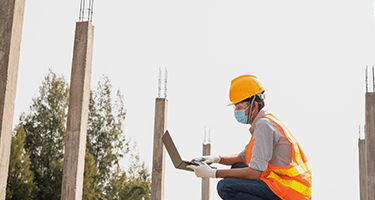Construction Companies Need Disruption More Than Ever
Industry disruption entered the global lexicon in 1995 and shaped the way we think about innovation in various industries. Startups, new technologies, digitization, and other digital disruption are incredible agents of change for many business models. In the construction industry, disruption comes in many forms, some of the most impactful may not be a reinvention of the wheel but rather a reimagining of how to use the wheel. But there is still room for significant industry disruption, whether it be at the project management level, incorporating automation into the construction process, changing the management of construction sites, and in other ways construction technology meets digital transformation and emerging technologies.
It is essential to take a step back and understand what disruption is to understand why companies in the construction sector need disruption. Only then can we know how it changes the landscape for various businesses and industries. Disruption typically takes the form of a new way of doing something that was often esoteric, complicated, or expensive that was not accessible to smaller players. For disruptive technologies to work, they must be effective from the bottom-up – companies or businesses without vast resources must be able to capitalize effectively on high-market solutions that are made accessible. The characteristics of genuinely disruptive technologies include:
- They are accessible with few barriers to adoption;
- They serve an expanding market set;
- They may not be evident in how they are immediately impacting an industry, but slowly and stealthily, they gain traction and then change an industry’s landscape.
Without being industry-specific, disruptive technologies include changes such as video streaming, online reference guides and encyclopedic knowledge (such as Wikipedia and other wikis), digital photography, LED bulbs, services such as Skype, and many more. These have in common that the technology was already there – it was just improved and used in a new and different way. So why do construction companies need disruption, and what new technologies or processes are on the horizon that can provide that disruption?
Why the Construction Industry Needs Disruption
The global construction industry is vast – it is a multi-trillion dollar industry accounting for significant global GDP share. It is also an impactful industry in multiple ways – construction creates and improves infrastructure and buildings that drive the economies of the world, while upstream markets generate significant global emissions. The industry also has many challenges it faces. For example, the pandemic is continually changing the way construction sites and businesses operate, the increasing cost of materials puts more pressure on companies, safety regulations and a prominent focus on safety require increased internal controls, and labor regulations require additional HR requirements and compliance measures. Unfortunately, disruption in the industry is limited.
Generally speaking, the construction industry relies heavily on existing technologies as there is little internal investment in developing new technologies. The industry is also highly fragmented, with industry operators filling specific niches that they are contracted or subcontracted to execute. Given these industry characteristics, a fundamental change in how the industry operates is not always a priority.
While the construction industry seems to do fine without significant disruptive changes to its business model, the unrecognized improvements are substantial. There are risks associated with not innovating, including losing market share to competitors, becoming less competitive in compensation and offerings, and more.
Disruptive Technologies and Services on the Horizon
There are many technologies and services currently available and in use by construction companies that are poised to fundamentally change construction processes and the construction industry as a whole. Startups such as Katerra, Fastbrick, Fetch Robotics, ClearPath Robotics, FBR, Sarcos, SuitX, and others aim to introduce either new equipment, new ways to access equipment, and entirely new processes to the industry, including robotics and exoskeletons, on-demand and niche-specific integrated construction services, modular construction, automated systems, and more. Service providers also are poised to change how the construction industry works. For example, Autodesk’s early disruption changed how Architecture, Engineering, and Construction (AEC) companies designed buildings – the integration of Building Information Modeling (BIM) by Autodesk and other providers is further changing the industry. There are also some innovative construction companies currently changing the construction methods for buildings or homes – some of these companies include: Apis Cor, which 3D prints buildings with on-site technology; Holobuilder, which offers 360-degree reality capture for construction collaboration; Kespry, which uses drones for progress tracking and job site mapping; and many others.
There are also new opportunities where disruptive technologies can transform the construction industry. New work processes, the adoption of technology, and supply chain diversification represent a few areas where digital disruption can create opportunities.
GoCanvas as a Disruptive Technology in the Construction Industry
GoCanvas is an excellent use-case highlighting the use of existing technologies to transform and disrupt industries, with the construction industry being no exception. GoCanvas takes relatively simple concepts present throughout the construction industry and changes their utilization in novel and impactful ways accessible to many customers.
Construction companies are leveraging GoCanvas to gain real-time insight into the entire construction process while increasing profitability on construction projects and maintaining high stakeholder satisfaction using highly accessible digital technologies. The various apps currently deployed in the GoCanvas store and custom apps that can be built in-house by clients or with help from GoCanvas reshape how companies evaluate job site performance, address safety issues, and meet project management requirements, and much more. The disruptive factor with GoCanvas is evident in the range of ways companies can use it – companies with limited resources can use daily reporting features, checklists, work orders, and more to streamline their processes and create efficiencies, while companies with more resources can integrate artificial intelligence and machine learning to develop novel insights based on data collected through GoCanvas on construction sites ranging from the anticipation of delays to identifying cost savings through supply chain modification and resource allocation. Regardless of how the end customers use it, GoCanvas is ready to revolutionize construction companies’ business models in impactful and meaningful ways.

Stay in Touch!
About GoCanvas
GoCanvas® is on a mission to simplify inspections and maximize compliance. Our intuitive platform takes care of the administrative tasks, freeing our customers to focus on what truly matters – safeguarding their people, protecting their equipment, and delivering exceptional quality to their customers.
Since 2008, thousands of companies have chosen GoCanvas as their go-to partner for seamless field operations.

Check out even more resources

The Ultimate Guide to Quality Control Inspections
Managing a construction project is a complex and stressful process. Among other things, you have to coordinate project team members, materials, and equipment and ensure that contractors are not afflicted by the potential risks and hazards present at the construction site. That said, quality means different things to different people which is why you should…

Constructions Digital Transformation
Your competition is finding faster ways to capture data and get critical insights from the field into their existing systems. In short, they’re not going bigger, they’re getting smarter. In this 15-minute broadcast on the construction industry’s digital transformation, find out why the trend is to modernize workflows – and how you can stay ahead of the curve…

See how VIP Lighting optimized efficiency with GoCanvas
VIP Lighting is a retail lighting and electrical maintenance business that services over 10,000 retail locations all over Australia and New Zealand. Before GoCanvas, VIP Lighting had two separate systems that were impossible to integrate, leading to inefficiencies. GoCanvas made it easy to integrate their systems into single, centralized platform…